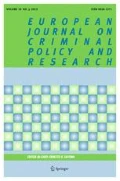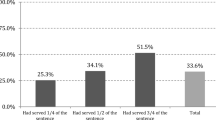Abstract
The motivation for prison leave in the Danish penal system is based on two rationales: humanity, because the maintenance of positive contacts outside prison is expected to further a future life without crime; and discipline, because the risk of being discredited and missing out on prison leave is expected to have an effect on prisoners’ compliance with the rules in prison. The Corrections Act contains certain framework provisions. The detailed regulation of prison leave is found within separate rules and guidelines. The power to make day-to-day decisions concerning the permission or revocation of prison leave lies in the hands of the prison administration. The regulation of prison leave and release on parole are interrelated, as the latter more or less directly depends on a successful period of regular prison leave. The total amount of prison leave is declining. Over the last few decades, more prison leaves have been granted for occasional reasons, such as being seen by a doctor, rather than oriented in preparation for release, such as to attend to job or education. It is argued that the decline in the total amount of prison leave and the increase in the total number of rejections of parole are directly and indirectly interrelated. It is further argued that political intervention in the well-established division of power between legislation and discretionary power jeopardizes transparency in decision-making and puts access to justice for prisoners at risk.






Similar content being viewed by others
Notes
The topic is introduced in a few books mainly directed at law students and the prison administration. The most thorough presentations are offered in Engbo, Straffuldbyrdelsesret, from 2005, pp. 275–295, and Vestergaard: Strafferetlige Sanktioner, from 2017, pp. 44–46. The topic is also touched upon in Storgaard and Skov, Probation in Europe. Denmark, from 2017. In 2017, Schiøler and Dragsted published the Corrections Act with interpretative comments and numerous references to the underlying regulation directed at practitioners. The Danish literature where prison leave is mentioned is of an educational character or in the form of handbooks; as such, it mainly explains the regulations in relation to this subject. However, the latest revision of the regulations on prison leave is from 2019, so this paper is, to a large degree, based on contemporary legal sources themselves.
There was a clause in Section 35 of the Criminal Code of 1930, which described a prisoner’s possibility of legally leaving the prison area during working hours if doing so was necessary in order to carry out obligatory prison work and only under the command and supervision of prison staff.
In the period 1965–2000, “going out” and prison leave were regulated in detail by numerous ministerial orders, departmental notices and guidelines for staff issued by the Department of the Prison and Probation Service after delegation from the Minister of Justice.
Most convicts in Denmark leave the courtroom after the trial with information about where and when they are supposed to turn up to serve the sentence.
The Department of the Prison and Probation Service.
Permission for regular prison leave may be revoked in the case of the failure to turn up at the right time after granted prison leave, the failure to comply with individual conditions imposed in accordance with Section 48, or new information indicating reasons to assume that the prisoner will misuse granted prison leave.
Identical systematization is followed in Fig. 3.
Regular prison leave for these purposes is normally reserved for the last part of the period of imprisonment. If the sentence is of 8 years or less, the duration of the period with regular prison leave of this type cannot exceed 3 months or 1 year if the aim is education. In closed prisons and if the sentence is of more than 8 years, this type of leave may be permitted for up to 1 year in length, even if it is work-related.
A so-called pension, which is an open institution belonging to the Prison and Probation Service. Residents are obliged to inform staff about their whereabouts and to stay in the houses overnight.
Contained in an official statement issued by the Department of the Prison and Probation Service of 30 July 2015 with detailed instructions about release on parole (Redegørelse om praksis for prøveløsladelse og genindsættelse) and more recently Ministerial Order no. 855 of 28 June 2017 (BEK nr 855 af 28/06/2017) and Instruction no. 9766 of 11 September 2018 (VEJ nr 9766 af 11/09/2018).
That is, Section 46 (3) of the Corrections Act for prison leave and Section 38 (4) of the Criminal Code for release on parole.
References
Albiston, C. R., & Sandefur, R. L. (2013). Expanding the empirical study of access to justice. Wisconsin Law Review, 2013, 101.
Dalberg-Larsen, J. (1994). Retsstaten Velfærdsstaten og hvad så? Akademisk forlag (2nd ed.).
Dignity (Danish Institute Against Torture). (2017). Isolation som disciplinærstraf – fakta ark. https://dignity.dk/wp-content/uploads/DIGNITY_Faktaark_Solitary_Confinement.pdf
Engbo, H. J. (2005). Straffuldbyrdelsesret (2nd ed.). Jurist og Økonomforbundets Forlag.
Greve, Vagn. 2001. Straffuldbyrdelsesloven – og andre væsentlige ændringer i det danske sanktionssystem. Nordisk Tidsskrift for Kriminalvidenskab, 88, Issue 1: 1–22.
Greve, Vagn et al. (1984). Criminal Law with Comments. Jurist og Økonomforbundets Forlag. Third edition. (This edition is now out of date and only valid for historical information.)
Koch, L. (1975). Om udgang og udgangsmisbrug. Nordisk Tidsskrift for kriminalvidenskab, 62. Issue, 3, 211–229.
Kriminalforsorgen i tal. (1989). Published by the Department of the Prison and Probation Service (not available on its website).
Lappi-Seppälä, T., & Koskenniemi, L. (2018). National and regional instruments in securing the rule of law and human right in the Nordic prisons. Crime, Law and Social Change, 70, 135–159.
Leitch, J. A. (2013). Looking for quality: the empirical debate in access to justice research. Windsor Yearbook of Access to Justice, 31(2), 229–255.
Melchiorsen, K. (2015). Væsentlige hensyn i straffuldbyrdelsesretten. Tidlig prøveløsladelse efter straffelovens § 40 a. http://law.au.dk/fileadmin/Jura/dokumenter/forskning/rettid/Phd_afhandlinger/2015/Kristines_Afhandling.pdf
Report 1099 of 1987. (1987). Straffelovrådets betænkning om strafferammer og prøveløsladelse nr. 1099. Statens Informationstjeneste.
Report 1181 of 1989. (1989). Betænkning om en lov om fuldbyrdelse af straf mv. Statens Informationstjeneste.
Rhode, D. L. (2013). Access to justice: an agenda for legal education and research. Journal of Legal Education, 62, 531–550.
Schiøler, J., & Dragsted, A. (2017). Straffuldbyrdelsesloven (2nd ed.). Jurist og Økonomforbundets Forlag.
Statistik. (2007). Kriminalforsorgen. Published by the Department of the Prison and Probation Service (not available on its website).
Statistik. (2017). The Prison and Probation Service. https://www.kriminalforsorgen.dk/wp-content/uploads/2018/12/kriminalforsorgens-statistik-2017-2-udgave.pdf
Statistik. (2018). The Prison and Probation Service. https://www.kriminalforsorgen.dk/wp-content/uploads/2019/10/kriminalforsorgens-statistik-2018-1.pdf
Storgaard, A. & Skov, L. (2017). Probation in Europe. Denmark. https://www.cep-probation.org/wp-content/uploads/2018/10/probation-in-europe-denmark.pdf
Storgaard, A. (2015). Dominant automatic release: Denmark. After prison you are free. In M. Herzog-Evans (Ed.), Offender release and supervision: the role of courts and the use of discretion (pp. 137–147). Wolf Legal Publishers.
Storgaard, A. (2017). Dänemark. In F. Dünkel (Ed.), Eletronische Überwachung von Straffälligen im europïaschen Vergleich – Bestandsaufnahme und Perspektiven (pp. 313–324). Forum Verlag Godesberg.
Author information
Authors and Affiliations
Corresponding author
Additional information
Publisher’s Note
Springer Nature remains neutral with regard to jurisdictional claims in published maps and institutional affiliations.
Rights and permissions
About this article
Cite this article
Storgaard, A. Prison Leave in Denmark: How a Tradition of Combining Rehabilitation with Discipline Developed into Putting Access to Justice at Risk. Eur J Crim Policy Res 26, 213–229 (2020). https://doi.org/10.1007/s10610-020-09436-5
Published:
Issue Date:
DOI: https://doi.org/10.1007/s10610-020-09436-5



